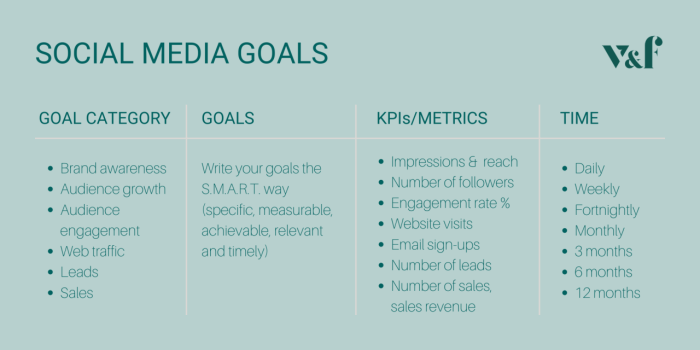Setting Social Media Goals is key to a killer marketing strategy. From boosting brand awareness to engaging your audience, clear goals are where it’s at.
Let’s dive into the world of social media goals and how they can take your online presence to the next level.
Importance of Setting Social Media Goals
Setting social media goals is crucial for a successful marketing strategy as it provides a clear direction for efforts and helps in measuring the effectiveness of campaigns. Without specific goals, businesses may struggle to achieve meaningful results and may not be able to track their progress accurately.
Enhanced Online Presence, Setting Social Media Goals
- Clear social media goals can help businesses grow their online presence by increasing followers, engagement, and website traffic.
- Having a goal to increase the number of followers by a certain percentage can drive targeted actions to attract a larger audience.
- Goals related to engagement metrics like likes, shares, and comments can encourage meaningful interactions with the audience, leading to a stronger online community.
Audience Engagement and Brand Awareness
- Well-defined goals have a significant impact on audience engagement as they provide a roadmap for creating relevant content that resonates with the target audience.
- Setting goals for brand awareness can help businesses reach a larger audience and improve brand recognition among potential customers.
- Measuring the success of social media campaigns against specific goals allows businesses to optimize their strategies and allocate resources effectively.
Types of Social Media Goals

When it comes to setting social media goals, it’s important to consider different categories that can help guide your strategy and measure success. Let’s dive into the various types of social media goals and how they contribute to overall social media success.
Brand Awareness
Brand awareness goals focus on increasing the visibility and recognition of your brand among your target audience. This type of goal is essential for reaching new customers and building a strong brand presence online.
- Example Goal: Increase brand mentions by 20% over the next quarter.
- Measurement: Track social media mentions, shares, and reach to monitor brand awareness growth.
Lead Generation
Lead generation goals aim to capture potential customers’ interest and gather information for future marketing efforts. This type of goal is crucial for expanding your customer base and driving sales.
- Example Goal: Increase lead form submissions by 15% in the next month.
- Measurement: Monitor the number of form submissions and track conversion rates from social media campaigns.
Community Building
Community building goals focus on fostering a loyal and engaged online community around your brand. This type of goal is important for creating brand advocates and driving customer loyalty.
- Example Goal: Grow social media followers by 25% within the next six months.
- Measurement: Track follower growth, engagement rates, and user-generated content to gauge community building progress.
Strategies for Setting Effective Social Media Goals
When it comes to setting social media goals, it’s important to be strategic and intentional. Here are some key strategies to help you set effective goals that align with your business objectives.
Setting SMART Goals
- Specific: Clearly define what you want to achieve on social media. For example, increasing brand awareness or driving website traffic.
- Measurable: Make sure your goals are quantifiable so you can track progress and success. Use metrics like engagement rates, follower growth, or click-through rates.
- Achievable: Set goals that are realistic and within reach based on your current resources and capabilities.
- Relevant: Ensure that your social media goals align with your overall business objectives and contribute to your company’s success.
- Time-bound: Establish a timeline for achieving your goals to create a sense of urgency and focus.
Aligning Social Media Goals with Business Objectives
It’s crucial to connect your social media goals with your broader business objectives to ensure that your efforts are driving tangible results. By aligning your goals with key business metrics such as revenue growth, customer acquisition, or brand loyalty, you can demonstrate the impact of your social media strategy on the bottom line.
Creating Actionable and Realistic Goals
- Conduct a social media audit to evaluate your current performance and identify areas for improvement.
- Define your target audience and tailor your goals to address their needs and preferences.
- Set specific objectives for each social media platform you use, considering the unique features and audience demographics of each channel.
- Establish KPIs (Key Performance Indicators) to measure the success of your goals and track progress over time.
- Regularly review and adjust your goals based on performance data and insights to ensure they remain relevant and effective.
Measuring and Evaluating Social Media Goals: Setting Social Media Goals

When it comes to social media goals, it’s crucial to track metrics and evaluate the success of your efforts. By measuring the impact of your strategies, you can make informed decisions and optimize your future goal-setting strategies.
Significance of Tracking Metrics
Tracking metrics allows you to quantitatively assess the performance of your social media goals. It provides valuable insights into what’s working and what’s not, helping you adjust your strategies for better results.
Key Performance Indicators (KPIs)
Commonly used KPIs to evaluate social media goals include:
- Engagement rate: measuring the level of interaction with your content
- Reach: determining the number of people exposed to your content
- Click-through rate (CTR): tracking the percentage of clicks on your posts
- Conversion rate: evaluating the number of users who complete a desired action
Analyzing Data for Informed Decisions
When analyzing data from your social media efforts, it’s essential to look for trends, patterns, and insights that can guide your decision-making process. By understanding the data, you can make adjustments to your strategies and set more effective goals in the future.





